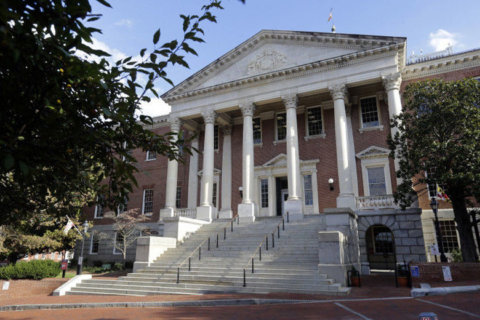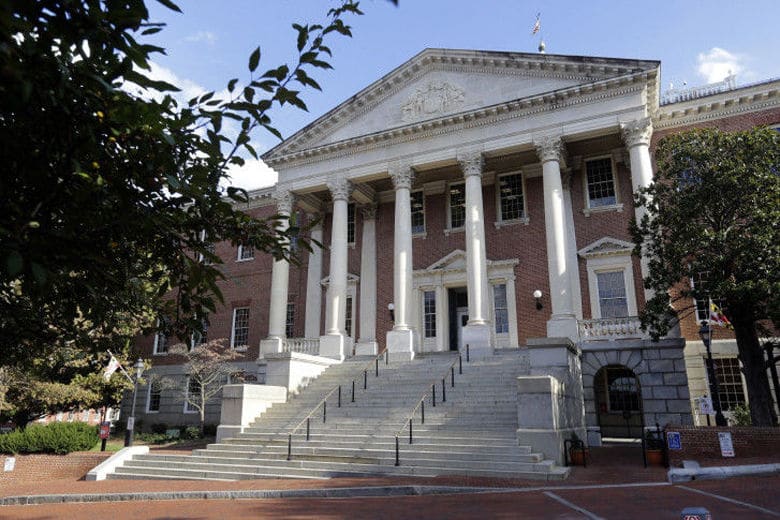This article was republished with permission from WTOP’s news partners at Maryland Matters. Sign up for Maryland Matters’ free email subscription today.

This content was republished with permission from WTOP’s news partners at Maryland Matters. Sign up for Maryland Matters’ free email subscription today.
Maryland’s economic recovery from a virus-induced recession continues to exceed expectations, and the state’s top fiscal leaders agreed Tuesday on revenue estimates that include a $299 million more for the 2022 fiscal year than was predicted even three months ago.
That increase would have been even higher, but the estimates incorporated veto overrides of a multibillion-dollar package of education reform and tax bills, as well as new tax reforms passed by the General Assembly in the last few weeks that would direct greater tax relief to Maryland’s lowest-income families, as part of a state-level stimulus program.
Overall, the state is expected to bring in just over $20.1 billion in revenue in fiscal year 2022, according to the new estimates, which were approved Tuesday afternoon by the Board of Revenue Estimates.
Andrew Schaufele, director of the Maryland Bureau of Revenue Estimates, credited the astounding resiliency of the state’s overall economy to its tax structure.
Income tax accounts for about 50% of state revenue.
The state’s income tax structure also means that a smaller share of wealthier homes pay more taxes — about 7.8% of households in Maryland earn more than $200,000 a year, but contribute 46.2% of the state’s total income tax revenue. And a larger share of lower income homes — 49.5% of Maryland households earned less than $50,000 a year, and contributed about 6.1% of the state’s overall income tax revenue.
A similar characteristic exists when it comes to state sales taxes, which accounts for 25% of state tax revenue.
New income tax estimates are expected to grow 5.3% in the 2021 tax year, and online sales tax revenues continue to surge, Schaufele said.
But Schaufele also cautioned that many Marylanders are struggling, and numerous factors could bring an end to the turnaround, he cautioned.
Maryland lost nearly 14% of all jobs — about 388,000 positions — during the depths of the COVID crisis, and overall employment is still down 4.9% — about the same percent of jobs that were lost in the state at the worst parts of the Great Recession and the economic downturn in the early 1990s.
“It seems remarkable that we’re having the revenue experience and the overall economic experience we’re having while were still in a pretty major jobs recession,” Schaufele said.
The industries with the largest continued job losses in Maryland are accommodations and food services, and arts and entertainment. Most jobs losses have been in lower wage industries, which is why there hasn’t been a large overall fiscal impact to the state.
Comptroller Peter V.R. Franchot (D) said the state will have to continue to struggle through a “K-shaped recovery,” in which some parts of the economy recovery quickly while others continue to struggle.
“Obviously today’s report is good news for the state’s bottom line underscores the strong bones of our state’s economy our ability to weather tough times,” Franchot said. “But it doesn’t represent the experience of literally hundreds of thousands of Maryland families who continue to face some of the toughest financial times of their lives right now. Every day of this pandemic further exposes the sobering fact that many Marylanders continue to suffer. The economic consequences of this pandemic have further widened the economic fault lines that we had before COVID.”
Stimulus success
Intense federal stimulus funding has bolstered enough parts of the state economy — even through periods of shutdown — to maintain state revenue levels, but could begin to fade.
Compared to the state’s last pre-COVID revenue estimates early last March, the new estimates are $185 million less for the current fiscal year, and $161.1 million more for the 2022 fiscal year — essentially a wash.
“The feds stepping in have really, really, really pushed the economic and revenue picture to the point where we’re effectively back to where we thought we’d be before we’d ever even heard of COVID,” Schaufele said.
Through January, the federal government pumped $26 billion into the state economy through traditional and expanded unemployment insurance, stimulus checks, the paycheck protection program and other support from federal stimulus bills.
Another round of stimulus funding — should the most recent nearly $2 trillion stimulus package be signed into law, as expected — could continue the trend. If passed, the total amount of stimulus funding expected in Maryland is likely to exceed $45 billion to $50 billion by August, Schaufele said.
That plan, the American Rescue Plan Act of 2021, would send stimulus checks of up to $1,400 to 75% of Maryland households, totaling $5.7 billion.
Extended federal unemployment benefits would bring an additional $3.9 billion to Maryland residents.
Tax changes, including an expansion of the child tax credit and Earned Income Tax Credit will likely have a significant impact.
And more than $8 billion is headed to the state to shore up state and local government revenues
“We’re talking about extraordinary sums of money,” Schaufele said about the federal stimuli.
But he and members of the revenue board cautioned that further rounds of stimulus were likely to end at some point and the economy could still falter.
Treasurer Nancy K. Kopp (D) commended the legislature and governor for extending state relief programs and suggested that “a prudent course” in future budgeting decisions would serve the state well.
Maryland Budget Secretary David R. Brinkley said the state should continue on a fiscally conservative path, given the uncertainty of the recovery.
“There are still a number of unknowns that could alter our fiscal path, this recovery could still turn into more of a sugar rush that crashes when these federal funds sources dry up,” Brinkley said.
The revenue estimates are the final figures that will guide the state budget process. The House Appropriations Committee is preparing to make final budget decisions this week.








